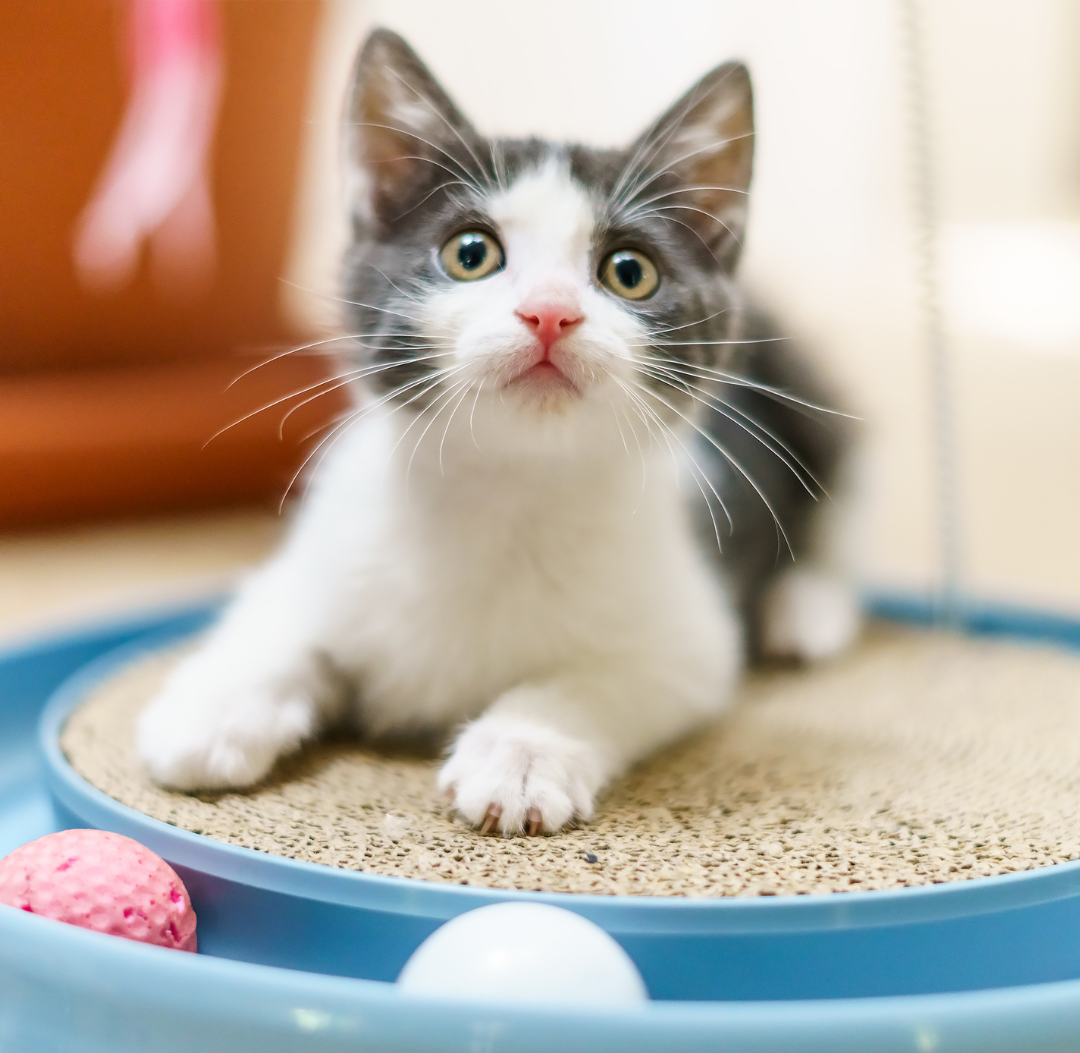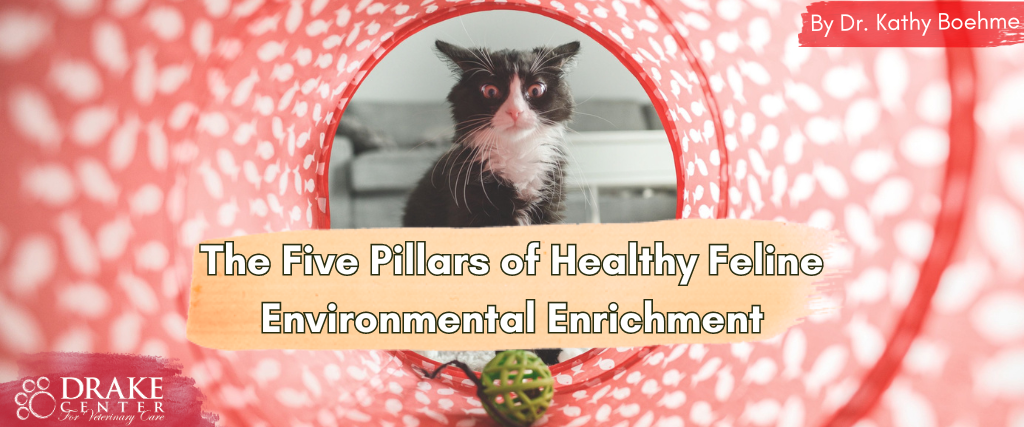The Feline Veterinary Medical Association established the 5 pillars to a healthy feline environment. These guidelines were created in order to reduce the incidence and to deal with the prevalence of feline behavior problems. I strongly encourage you to check out their valuable and informative website.
Here are the 5 pillars of healthy feline environment:
1. Safe places to hide
2. Multiple and separate key environmental resources: water, food, litter box, scratching areas
3. Opportunities for play including predatory play that mimics natural hunting behavior
4. Positive and predictable human social interactions
5. Respecting their sense of smell. In addition to being a predator, cats are also prey for other species and are dependent on their sense of smell to feel safe. When strong odors are present, they lose the ability to see the world and hence safety, through their nose. Avoid scented cat litter or strong essential oils around cats.
Here is more information regarding each pillar:
Provide a Safe Place
- Cats need to feel safe and secure in their home. We should provide multiple elevated perches, such as cat trees or appropriate shelving, to allow cat(s) to observe their environment safely from above. This helps them cope with the stress of indoor living. Offer opportunities to hide that are enclosed with various entrances and varied textures, from cozy, warm fleece blankets to cardboard boxes.
- A cat carrier left out in the commonplace of the home can provide both a hiding or resting place while forming a positive association that is occasionally tested by travel or veterinary visits.
Provide Multiple and Separated Key Resources
- When cats are forced to interact with other animals or people in the home to access their key resources (e.g., food, water, litter boxes, hiding spots), chronic distress, medical issues, and behavioral issues can result.
- These resources should be provided in multiple and various locations to minimize inter-cat competition even when cats that live together appear to get along fine.
- Even single cat households should offer cats options for drinking, toileting and resting.

Provide an Opportunity for Species-Appropriate Play
- Cats are active hunters, with some reported to spend approximately 50% of their day foraging and hunting for food. Indoor cats often suffer from boredom and obesity and need an appropriate outlet for play.
- Food puzzles are an excellent means of increasing both physical and mental stimulation.
- Visit food puzzles for a range of puzzle ideas as well as an excellent handout on helping us use food puzzles with cats.
- Cats have a predatory play style that includes stalking, chasing, pouncing, and biting. This type of play can sometimes be directed at humans, especially if the cat has no other outlets for play. Toys that can direct this play to an appropriate target include wand toys, battery-operated toys that mimic prey, and catnip-filled toys.
- To prevent frustration, undesirable unruly problems, or competition, we should provide opportunities for mental enrichment. This can be done by feeding meals in food puzzles or hiding food toys around the house. By offering a variety of toys and rotating them frequently, cat interest can be maintained.
- Cats need to exercise. It is a health risk for them to go into their senior years depleted of lean muscle. Lack of activity and play is a major cause of lean muscle loss in indoor cats. We are just learning the critical role of interactive play for both mental and physical wellbeing in cats. We now know that play is not just something we do when we have the time. It should become a regular scheduled part of our cat’s day even if it is only 5-10 minutes twice daily. (see below for some interactive cat toy recommendations).
Provide Consistent, Positive, and Predictable Human Interaction
- Humans are the most influential factor in cat welfare.
- General guidelines include avoiding punishment (e.g., physical or verbal reprimands, harsh noises, spraying with water) and establishing a regular routine for feeding, play, and interaction.
- If changes to the routine are needed, gradual changes are recommended to allow the cat to acclimate.
- Changes in routine can cause distress and subsequent illness, including vomiting, decreased appetite, and house soiling.
- Contrary to popular belief, cats are trainable. Positive reinforcement training gives a cat the opportunity to use behavior for the desired outcome and can decrease stress and anxiety (see below for resources on training your cat)
Provide an Environment That Respects the Cat’s Sense of Smell
- Cats depend much more on their sense of smell than humans do. A cat’s sense of smell allows it to both detect potential threats and feel secure in the environment.
- Cats mark their environment with pheromones by rubbing or scratching objects. These forms of marking establish the cat’s core living area—where it feels safest and most secure - and where it communicates with other cats.
- Whenever possible, we should avoid interfering with our cat’s sense of smell and provide appropriate outlets for scratching.
- Cats find some novel smells, detergents, and harsh cleaners stressful. The product Feliway, a feline facial pheromone, encourages familiarity in the environment. Many cats enjoy enriching smells such as catnip and cut grass.
- Here's an excellent book on understanding your cat’s behavior and troubleshooting common behavioral problems: Decoding Your Cat by The American College of Veterinary Behaviorists

Here are some great toys for cats:
DaBird: Feather toy
GoCat Cat Catcher: Mouse-like toy
Cat Dancer: Mimics chasing a bug
Boinks Bamboozler: Snake-like toy
Food Puzzles also fight boredom and stimulate your cat
Here's an excellent book on understanding why play is so important in cats and how to do it:
Play With Your Cat!: The Essential Guide to Interactive Play for a Happier, Healthier Feline
by Mikel Maria Delgado PhD
And lastly, here are other feline resources:
Calming Supplements -
Solluquin
Anxitane
Purina Calming Care Probiotic
Feliway
Resources for training your cat -
Here's an excellent book on training your cat:
The Trainable Cat: A Practical Guide to Making Life Happier for You and Your Cat

